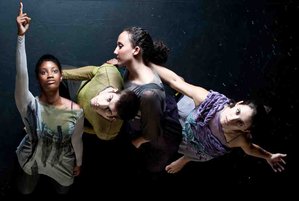By Merilyn Jackson
For The Inquirer
Hailing from Richmond, Va., Anderson earned a master of fine arts from Temple University and is now an associate professor of dance at Muhlenberg College, where he also heads the African American studies program. For World Headquarters, he was inspired by the late science fiction writer Octavia Butler, but also drew on Essex Hemphill, Sam Shoemaker, and Walter Benjamin for what was a bit too much text that he wrote with Dwyer.
Anderson virtually turned the Painted Bride into a makeshift encampment. He had a section of seating removed and replaced with scrounged objects from children’s books to walkie-talkie, from teepee to TV. The dancers visited this set from time to time but danced mostly on the stage, which held additional seating to accommodate the large audience.
As Professor Bankole Olamina, Anderson led the eight ragtag survivors of “The Pox” in dances ritualistic and mournful. Anderson’s robust dancing hangs from his powerful, undulating shoulders and ripples electrically through his body’s bent knees, essed torso, and imploringly released fingers. Raising the staff he wields, he is clearly the Moses of this tribe.
In the beginning, he leads them in the piece’s most poignant dance. All wear mesh hoods and, with bodies bent over in grief, propel themselves forward as best they can.
It was good to see Michael Velez dancing locally again. He’s late of Koresh Dance Company and working in San Francisco. As Zebulon Pierce, he represents the progenitor of what could be the next generation of these survivors. Shavon Norris and Karama Butler stood out even in the group dancing, but all performed this work they helped create with conviction and skill. In this parable of parables, Butler, as Olamina’s daughter, states: “God is change.”
